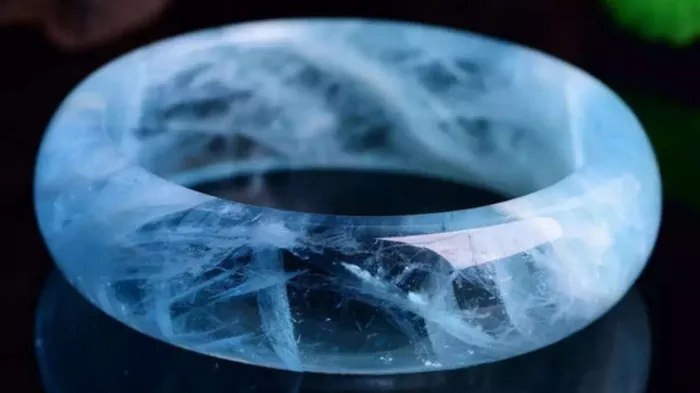Aquamarine, with its ethereal blue hues reminiscent of tranquil waters, has captivated gem enthusiasts for centuries. However, within this mesmerizing spectrum lies a rare subset, coveted for its elusive beauty and scarcity. In this comprehensive exploration, we embark on a journey to uncover the secrets of the rarest colors of aquamarine, delving into their formation, characteristics, and allure.
The Genesis of Aquamarine:
Before we delve into the rarest shades of aquamarine, it’s essential to understand the gemstone’s origins. Aquamarine belongs to the beryl family, a mineral group that includes emerald and morganite. Its distinctive blue coloration is primarily attributed to traces of iron within its crystal structure.
The formation of aquamarine occurs in pegmatite veins, where hydrothermal activity facilitates the growth of large crystals over extended periods. These geological processes imbue aquamarine with its renowned clarity and transparency, characteristics highly prized in the world of gemstones.
Unlocking the Spectrum:
Aquamarine’s color spectrum ranges from pale blue to deep azure, with variations influenced by factors such as trace minerals and light exposure. The gem derives its name from the Latin words “aqua” and “marina,” meaning water and sea, respectively, evoking imagery of the ocean’s serene depths.
The most common hues of aquamarine encompass shades of light blue and green-blue, exhibiting a tranquil clarity reminiscent of tropical waters. However, within this spectrum lies a select group of colors that transcend the ordinary, captivating collectors and connoisseurs alike.
Rare Aquamarine Varieties:
Among the myriad hues of aquamarine, several rare variations stand out for their distinctiveness and scarcity:
Paraiba Aquamarine: Named after the Brazilian state of Paraiba, this variety of aquamarine is celebrated for its striking neon-blue hue. The presence of copper impurities lends Paraiba aquamarine its vibrant coloration, setting it apart from conventional specimens. Its rarity and intense coloration make it highly sought after by collectors, commanding premium prices in the gemstone market.
Santa Maria Aquamarine: Originating from the Santa Maria de Itabira mine in Brazil, Santa Maria aquamarine is renowned for its deep blue coloration reminiscent of the clear skies on a summer day. Manganese impurities infuse this variety with its distinctive hue, ranging from sky blue to rich azure. Due to the limited availability of rough material from the Santa Maria mine, specimens of this coveted variety are exceedingly rare, making them prized possessions among gem aficionados.
Maxixe Aquamarine: Maxixe aquamarine, also known as “black aquamarine,” defies conventional expectations with its unexpected coloration. Unlike its blue counterparts, Maxixe aquamarine exhibits a dark, inky hue ranging from deep blue to black. This enigmatic coloration is attributed to the presence of iron within the crystal lattice, which undergoes irradiation-induced changes over time. Despite its unconventional appearance, Maxixe aquamarine possesses a unique allure, appealing to collectors fascinated by its mysterious charm.
Bi-Color and Tri-Color Aquamarine: Bi-color and tri-color aquamarine varieties showcase a mesmerizing interplay of hues within a single gemstone. These specimens feature distinct color zoning, with bands of blue, green, or even pink delineating different growth phases during crystallization. Bi-color aquamarine typically exhibits a transition between blue and green hues, while tri-color specimens incorporate a third color, such as pink or peach, adding an extra dimension to their visual appeal. The rarity of well-defined color zoning contributes to the desirability of these unique aquamarine varieties among collectors and jewelry enthusiasts.
Preserving the Rarity:
Despite their allure, rare aquamarine varieties face conservation challenges stemming from overexploitation of gemstone deposits and environmental degradation. Unsustainable mining practices, coupled with increasing demand for rare gemstones, pose threats to the long-term viability of aquamarine resources.
To address these challenges, initiatives promoting responsible mining practices and environmental stewardship have gained momentum within the gemstone industry. Certification programs such as the Responsible Jewelry Council (RJC) and initiatives like the Gemstone Ethical Initiative (GEI) aim to promote ethical sourcing standards and environmental sustainability across the supply chain.
Furthermore, efforts to support local communities dependent on gemstone extraction have led to the development of fair trade initiatives and community-based mining cooperatives. By fostering equitable partnerships and supporting sustainable livelihoods, these initiatives contribute to the preservation of aquamarine resources while empowering artisanal miners and their communities.
Conclusion:
In conclusion, the rarest colors of aquamarine embody nature’s artistry, captivating beholders with their elusive beauty and mystique. From the neon-blue brilliance of Paraiba aquamarine to the inky depths of Maxixe specimens, each variety tells a story of geological processes and elemental forces shaping Earth’s treasures.
As custodians of these precious gems, it is incumbent upon us to uphold principles of sustainability and ethical stewardship, ensuring that future generations can continue to marvel at the splendor of rare aquamarine varieties. Through responsible mining practices, conservation efforts, and support for artisanal mining communities, we can preserve the legacy of these extraordinary gemstones for posterity, safeguarding their beauty for generations to come.


